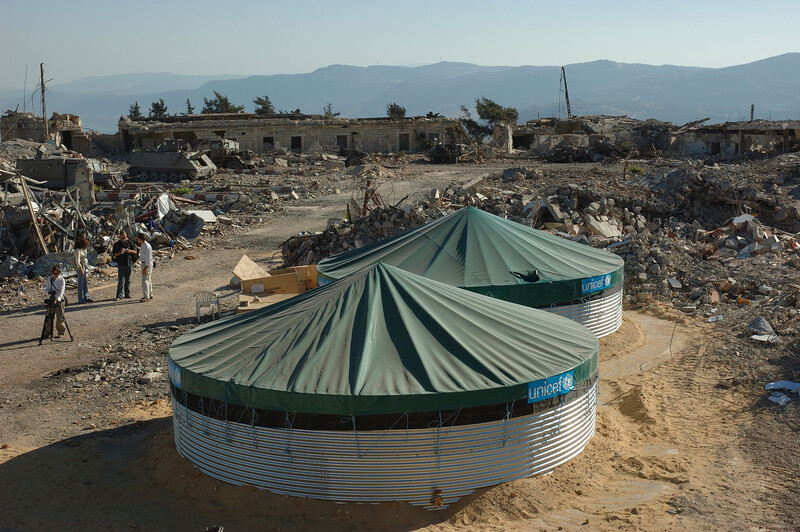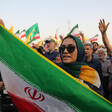Rights and Accountability 20 March 2020

The remains of Khiam prison after Israel bombed it in 2006. Israel and its collaborators tortured detainees at the prison during their occupation of southern Lebanon that ended in May 2000. (United Nations)
Secretary of State Mike Pompeo is welcoming an accused torturer and murderer back on American soil.
“American citizen Amer Fakhoury, who has been in detention in Lebanon since September, is returning to the United States where he will be reunited with his family and receive urgent medical treatment,” Pompeo announced Thursday.
“His return comes as a relief to those who have followed the case with grave concern. We are relieved to be able to welcome him back home.”
This perverse statement makes no mention of why Fakhoury was detained in Lebanon – as if he were the victim of some grave injustice.
Fakhoury worked at the notorious Khiam prison that operated in Israeli-occupied southern Lebanon from 1985 until Lebanese resistance forces drove out the Israeli military and its South Lebanon Army collaborator militia in May 2000.
Israel occupied southern Lebanon from 1978, and mounted a full-scale invasion in 1982, when its army killed tens of thousands of people and besieged and occupied Beirut.
A Lebanese military judge however ordered Fakhoury’s release this week, on the basis that too much time had passed since his alleged crimes.
Lebanese prosecutors appealed the release, but before any further proceedings could be mounted, the US airlifted Fakhoury out of its embassy by helicopter.
“We are very grateful to the Lebanese government for working with us and we are very proud of his family,” President Donald Trump said on Thursday.Lebanon’s failure to prevent the American operation to remove Fakhoury is being seen by some as a sign of the state’s weakness and complicity.
Amid growing outrage over Fakhoury’s escape from justice, the head of the Lebanese military tribunal resigned on Friday.
Lebanon’s foreign minister reportedly summoned the US ambassador and asked her to explain “the circumstances of Amer Fakhoury being transferred abroad from the US embassy.”
In a televised speech Friday night, Hasan Nasrallah, the leader of Hizballah, denied there had been any deal to release Fakhoury, despite enormous US pressure on Lebanon’s government.
Hizballah, which is part of the government, said that the US had threatened to blacklist Lebanese officials and stop military aid to the country unless Fakhoury was released.
Nasrallah said Hizballah had no advance knowledge of the release and called for an inquiry into what occurred.
Torture and murder
Fakhoury’s arrest in September, after he returned to Lebanon, offered hope of justice to the families of many of his alleged victims. That hope now appears to be dashed.
One such family member is Ola Hamzeh.
Her father, Ali Abdallah Hamzeh, spent the last hours of his life in March 1986 tied to a pole in Khiam, “what would eventually become the most notorious detention center for torture and ill-treatment in then-Israeli-occupied southern Lebanon,” Middle East Eye reported in September.
“He was 42 years old, a father of three children, and a teacher at a local school in the village of Jmayjmeh in southern Lebanon.”
According to former detainees, Hamzeh died within two weeks of his abduction. The South Lebanon Army never returned his body to his family.
Former detainees say Fakhoury commanded the prison when conditions were at their worst, particularly between 1986 and 1995, according to Middle East Eye.
Over many years, Amnesty International documented the torture methods at the prison, including “Filthy hoods, relentless interrogation through beatings, repeated suspension from an electricity pylon, dousing with water, and electroshocks.”
The human rights group noted that many detainees were first taken to Israel for interrogation and then sent to Khiam, or vice versa.
Many of those held were simply civilians taken hostage by the Israelis to be used as bargaining chips in negotiations with resistance organizations including Hizballah.
Liberation
This horror came to an end on 23 and 24 May 2000. Witnesses told Amnesty researchers that “all of a sudden, around midday on 23 May, there was the dramatic liberation.”
“No jailers showed up with the keys to the cells, they actually ran away from the prison to join other [South Lebanon Army] members streaming to the border to seek refuge in Israel, as Israeli troops rushed themselves to the border.”
The people of the town of Khiam “acting out of the momentum created by the hurried and confused Israeli withdrawal, went to the detention center demanding the liberation of the prisoners.”
Among those fleeing to Israel was Fakhoury. He eventually made his way to the United States where despite – or perhaps because of – his alleged role in human rights crimes, he obtained citizenship.
I visited Khiam prison in late June 2000. It was just weeks after the Israeli defeat.
The mood in the south was still jubilant in every town and village we visited – I was with several people who had also been in Lebanon attending a conference in Beirut of the American Association of University Graduates.
People from all over Lebanon were streaming to the newly liberated territories, many laying eyes on a stunningly mountainous and rugged part of their country for the first time.
Residents of the south, many recently returned from Beirut where they had lived as displaced persons, welcomed us joyfully. In town squares, destroyed or captured Israeli military equipment was on display, festooned with Lebanese and resistance flags.
The most memorable part was our visit to Khiam.
It was a series of low stone buildings up on a hill, originally constructed as French army barracks in the 1930s. I will never forget entering the dormitory cells – dark and dingy rooms with bunk upon bunk crowded together.
It looked as if the prisoners had been there that morning: Clothes and underwear were still hanging on lines above the beds and personal notes and letters were pinned on walls. The liberation of the prison had been so sudden that everything was frozen in place and it almost felt like a violation of privacy to be in those spaces.
I remember the row of solitary confinement cells – these were shown to us by former prisoners who were now acting as guides. There was a courtyard and a row of solid metal doors. Inside was a bare stone space about one by two meters.
It was impossible to imagine spending an hour inside one of those cells, let alone weeks, months or years.
One of the most famous people to be held in such a cage was Lebanese resistance hero Souha Bechara. In 1988, at the age of 21, Bechara attempted to assassinate Antoine Lahad, the head of Israel’s South Lebanon Army collaborator militia.
She too was tortured. As she wrote in her memoir, Resistance: My Life for Lebanon, she was “thrown to the ground and lashed with a studded whip on my legs and the soles of my feet,” leaving her in unbearable pain. She was also subjected to electric torture.
Bechara spent 10 years in Khiam, six of them in in solitary confinement.
She described being thrown in a “minuscule box with no mattress or blanket.” She was given a little food and a cup of water once a day. “In theory, I was allowed to go and wash myself once a week, although they often forgot to take me out of my cave.”
She has spoken about her torture and how she and other prisoners resisted, in numerous interviews, including this one from 1999:
And then there was the electric shock torture room.I remember this as a single story brick building, with thin wires strung up along the ceiling and wall to some sort of device that looked like it might be used to jump-start a car.
It all looked very makeshift, but according to our guides it was a place of horrific suffering and pain inflicted by the Israelis and the traitors who worked with them.
During its 2006 invasion of Lebanon, Israel bombed Khiam prison in an attempt to destroy a monument and memorial to its crimes – though survivors continue to maintain the site.
In 1999, Israel admitted what survivors of the prison had long reported: that Israeli personnel were directly involved in interrogations at Khiam.
That admission, Human Rights Watch stated, must be used as part of efforts to hold “accountable Lebanese and Israelis responsible for systematic acts of torture that have occurred there over the past two decades.”
But two more decades later, Israel and its collaborators continue to enjoy impunity. Instead of facing justice, those involved in that cruelty, like Fakhoury, are welcomed to the United States as heroes.




